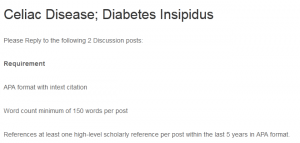Celiac Disease; Diabetes Insipidus

Please Reply to the following 2 Discussion posts:
Requirement
APA format with intext citation
Word count minimum of 150 words per post
References at least one high-level scholarly reference per post within the last 5 years in APA format.
Plagiarism free.
Turnitin receipt.
DISCUSSION POST # 1 Betsy.Celiac Disease; Diabetes Insipidus
Case study Celiac Disease
The case study selected is of a 19-year-Old patient that presents to the hospital with increasing diarrhea and constipation. Further, the patient has a history of celiac disease.
Role of Immunity and Celiac Disease
Immunity plays a critical role in celiac disease. Celiac disease arises as a result of an immune reaction to gluten which is a protein that is primarily found in wheat, barley, and rye as; results after eating gluten; it triggers an immune response in the small intestine. According to Anderson (2020), adaptive immunity plays a critical role in the early and late impacts of gluten, where the adaptive immunity response selectively engages gluten and the impacts that arise from its effect on the body.
Gluten and Celiac Disease
Celiac disease arises after the consumption of gluten, and the body commences attacking its body tissues after the patient consumes gluten. This arises in response to the immune system reacting to gluten, causing damage to the gut, making it hard to take in nutrients. Caio et al. (2019) argue that the only treatment for celiac disease is a lifelong strict gluten-free diet that can ultimately improve the quality of life and prevent other effects arising from the condition, for instance, lymphoma.
Pathophysiology of Diarrhea and Constipation
Diarrhea arises as a result of augmentation of the water content in the stool because of an imbalance in the normal functioning of the physiological processes of the small and the large intestines because of failure to absorb the various nutrients, ions, and water (Nemeth & Pfleghaar, 2022). Usually, the water content is approximately 10mL/kg/day in infants and young children and in teenagers and adults 200g/day. In the case of this patient, the absorption of water from the stool can result in constipation. Further, a gluten-free diet can result in a reduction in the fiber content in the food, thereby causing constipation.
Case study Diabetes Insipidus
Sodium Level with Diabetes Insipidus (DI)
Patients with DI have excessive urine output resulting in excessive thirst. For the patient in the scenario, blood sodium level can be normal if she was able to drink enough fluid to compensate for excessive urine output, or may be slightly high if she was not able to drink enough fluid.
Elevated Osmolarity
If the patient’s osmolarity is elevated, it means that her fluid intake was insufficient to compensate for the excessive urine output. Excessive low osmolarity urine appears pale or colorless. Without adequate amount of appropriate fluid intake, the low osmolarity urine results in elevated serum osmolarity.
Central DI vs Nephrogenic DI
The four types of DI are central DI, nephrogenic DI, gestational DI, and dipsogenic DI. Central DI is associated with the hypothalamus or pituitary gland, which presents as inappropriate antidiuretic hormone (ADH) levels in blood. ADH is an important water homeostasis hormone. The hypothalamus produces ADH and stores it in the posterior pituitary gland. The hypothalamus also monitors serum osmolarity in the body, and regulates ADH release. ADH tells the kidneys how much water to conserve to keep serum osmolarity within safe range. Nephrogenic DI occurs when the kidneys do not respond to ADH appropriately, resulting in excessive urine output and severe thirst.
Mechanism of Desmopressin Acetate (DDAVP)
DDAVP mimics ADH. DDAVP is a synthetic analogue hormone selective for ADH V2 receptors (Vassiliadi & Tsagarakis, 2018). These receptors control renal water retention by increasing water permeability in the renal tubule cells (McCarty & Shah, 2021). This results in decreasing urine volume and increasing urine osmolarity.